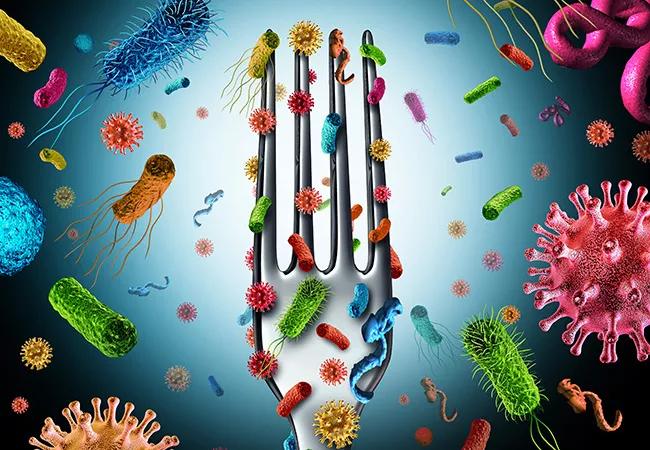Study focused on post-diarrheal hemolytic-uremic syndrome

Foodborne diseases pose a major public health risk. FoodNet (Foodborne Diseases Active Surveillance Network) — a national, population-based initiative funded by the Centers for Disease Control and Prevention (CDC) — tracks and monitors laboratory-confirmed cases of bacterial or parasitic infections caused by foodborne pathogens. Lerner Research Institute investigator Asha Kallianpur, MD, MPH, Genomic Medicine Institute, has worked with FoodNet researchers to identify for the first time host genetic variants associated with a serious complication of infection caused by one of these pathogens, Shiga toxin-producing Escherichia coli (STEC).
Advertisement
Cleveland Clinic is a non-profit academic medical center. Advertising on our site helps support our mission. We do not endorse non-Cleveland Clinic products or services. Policy
While STEC causes several different types of infections, Dr. Kallianpur’s study focused on post-diarrheal hemolytic-uremic syndrome (D+HUS). D+HUS is caused by STEC infection acquired through consumption of contaminated food or water or contact with farm animals. The diarrheal illness can cause multi-organ failure as a result of widespread clotting in small blood vessels and other vascular damage, which occasionally involves the central nervous system. D+HUS is a leading cause of kidney failure in children, but also affects adults and can be life-threatening in either age group, as shown by the serious 2011 STEC-related HUS outbreak in Germany, which resulted from contaminated bean sprouts.
Another form of hemolytic-uremic syndrome, called familial HUS, is caused by inherited mutations in genes that encode complement proteins, which play important roles in blood clotting and the immune system. Conducting genetic studies amidst infectious disease outbreaks is very difficult, however, so familial HUS is far more studied and better understood than D+HUS. Dr. Kallianpur and her collaborators, including Tennessee Department of Health epidemiologist, Tim Jones, MD, sought to build on knowledge gained from studies of familial HUS, and on FoodNet infrastructure, to explore for the first time the genetic susceptibility factors related to D+HUS.
The researchers analyzed biological samples from over 800 patients identified through FoodNet who were hospitalized with STEC-related diarrhea. They focused on 641 patients who were exposed to the most common bacterial variation of STEC that causes HUS, called STEC 0157:H7. They compared those who went on to develop confirmed D+HUS, as defined by clinical or laboratory criteria, with individuals who recovered without complications. Based on the assumption that genetic causes of D+HUS and familial HUS likely overlap, the researchers scanned the samples for 200 carefully selected genetic variants known to be associated with familial HUS or with closely related disease processes.
Advertisement
They found that 12 of these variants were significantly associated with D+HUS. Five variants were associated with D+HUS diagnosed by any criteria, while seven were associated with the most stringently defined cases of D+HUS, which also met all four laboratory criteria for diagnosis. Statistical analyses revealed that eight of the variants increased disease risk (COL11A1, CFHR1-5, TFRC, GP1BA, B2M, TLR4, TNFR1 andIL6R), while others were protective (including EDN1, C4BPA). Although each of the variants are involved in different cellular pathways — ranging from platelet and blood vessel function to cytokine signaling or iron transport — they do share one defining feature: most of the variants are within non-complement genes.
Taken together, the findings suggest targeting these genes and pathways to prevent the over-exuberant immune response that causes D+HUS may be a possible treatment strategy. The genes and pathways identified represent novel and, in many cases, viable targets for future therapeutic interventions. This study offers hope that a customized genetic panel might one day exist and be used to help clinicians risk-stratify individuals who are exposed to STEC, and administer treatments that are tailored to their risk profile.
Although this is the largest study of host susceptibility in D+HUS conducted to date, the number of D+HUS cases in the sample was still small, and additional confirmatory studies are needed. These early findings suggest that the power of precision medicine might be harnessed even to combat major public health threats like outbreaks of foodborne infectious disease.
Advertisement
The study was published in the Journal of Infectious Diseases and funded by the Centers for Disease Control and Prevention.
Advertisement
Advertisement

First full characterization of kidney microbiome unlocks potential to prevent kidney stones

Researchers identify potential path to retaining chemo sensitivity

Large-scale joint study links elevated TMAO blood levels and chronic kidney disease risk over time

Investigators are developing a deep learning model to predict health outcomes in ICUs.

Preclinical work promises large-scale data with minimal bias to inform development of clinical tests

Cleveland Clinic researchers pursue answers on basic science and clinical fronts

Study suggests sex-specific pathways show potential for sex-specific therapeutic approaches

Cleveland Clinic launches Quantum Innovation Catalyzer Program to help start-up companies access advanced research technology